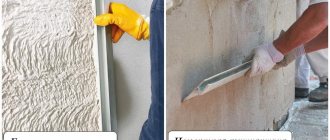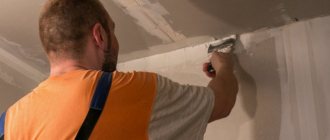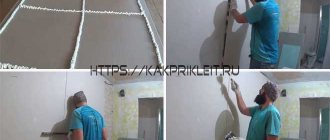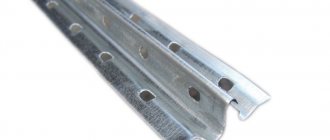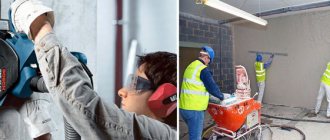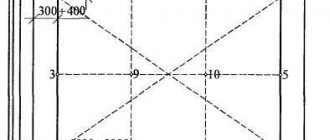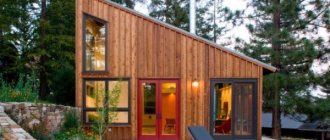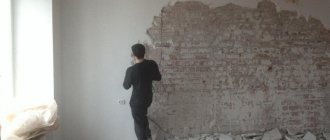When is it better to use drywall instead of plaster?
Smooth, even walls are the basis of repairs. Drywall boards can produce quick and effective results (with proper assembly and careful joining of sheets). They not only level the surface, but also help hide various defects.
If the humidity in the room is high, then you can use sheets with water-repellent impregnation. The material can even be laid on a wooden base and rounded elements. GCR is also suitable for finishing various partitions, suspended ceilings, and covering small sections of walls.
For walls, gypsum board sheets with a thickness of at least 12.5 mm are used. Moisture-resistant material (with special impregnation) is often used for finishing commercial premises, less often in apartments.
Products can be attached to the wall immediately after priming. Plasterboard sheets are easily connected to each other (they are pre-cut to obtain the desired size, since standard plasterboards on the market are 120x200 or 120x300 cm). Before gluing the sheets, you should completely remove the old plaster from the base (this also applies to other coatings).
Installation of material on different bases
The glue is available in the form of a dry mixture. To prepare the solution, mix the powder with water (it is extremely important to follow the manufacturer's recommendations). The temperature in the room where the boards are glued should be within +10…+35°C. If the index is high, the glue may dry out too quickly, which will negatively affect the quality of the coating. The solution is applied using a spatula (both on the plasterboard itself and on the wall).
Drywall or plaster - which is better:
- As for ceilings, you can finish them with either plasterboard or plaster. If gypsum boards are used, they should be laid on special frames. Gluing panels to the ceiling, as is done for walls, can cause the sheets to peel off.
- For rounded surfaces, depending on the radius of the circle, different materials are used. Flexible plasterboard sheets are only suitable for slightly curved surfaces; they are not used if the base is strongly rounded.
- For more curved surfaces, you can use semicircular metal panels that will allow you to install drywall (on rounded corners of walls, arched openings, etc.).
In what cases is it better to use
Having found out the advantages and disadvantages of the materials in question, you can decide which is better, plaster or drywall for walls in each specific case. To make a decision, you will need to analyze the input data: the degree of deviation of the vertical wall, the base material, whether the manufacture of complex structures is required to give the interior the intended appearance, operating conditions of the room, the need to mask any structures and communications, what material is planned to be applied as finishing cladding on the walls and the experience of the master.
An important issue is the cost of materials. Plaster solutions are cheap, but require a more highly qualified finisher; drywall is more expensive; in addition, guides and fasteners will be needed to install the sheets, although even a novice craftsman can handle covering walls with this material.
Drywall
To resolve the doubt whether it is possible to cover the walls with plasterboard instead of plaster, the following list of circumstances in which the installation of plasterboard is preferable will help:
- if the base is a wooden surface, for example, in a country house or country house, when they are a permanent place of residence;
- if necessary, disguise internal communications without the use of tedious gating and if there is free space in the room;
- if there is a need for additional insulation of the room or sound insulation;
- with significant differences in the vertical wall (more than 20 mm);
- if it is necessary to complete finishing work in the shortest possible time;
- when doing the work yourself, when it is not possible to hire a professional to plaster the walls;
- if necessary, eliminate flaws in masonry made of aerated concrete, gas silicate blocks, bricks and foam blocks;
- in cases where it is necessary to eliminate protruding parts of the foundation made of FBS.
In ambiguous conditions, when it is possible to use both materials, you should calculate whether it is cheaper to level the walls - with plasterboard or plaster, and then make a decision.
Plaster
If you need to decide how best to level the walls - with plasterboard or putty, the main criterion for making a decision is the magnitude of the vertical difference of the base and the purpose of the room.
For small vertical deviations, you can use gypsum plasterboard and plaster the surface, but if you are going to hang heavy shelves or other objects on such walls, you will only have to plaster the base.
Leveling plaster is used in the following cases:
- when preparing bases for subsequent finishing with heavy materials (decorative stone slabs);
- for leveling the surface in rooms with high humidity levels (in the bathroom);
- if it is necessary to secure massive objects to the walls;
- in small rooms when you need to save space;
- when the treated surface deviates from the vertical within 20 mm;
- in rooms where sudden changes in temperature and humidity conditions are possible.
Plaster
Plastering is a classic option for preparing walls and ceilings, both for painting and wallpapering.
Previously, to apply plaster, it was necessary to mix individual ingredients in certain proportions; with the advent of dry mixes, the process of preparing a solution for plastering has become significantly simplified.
Special building mixtures, filling unevenness and defects, at the same time even out the color of the surface.
Recently, the implementation of concrete floor screed has become much easier, which is associated with the advent of dry concrete mixtures. Dry mix for floor screed is popular and affordable.
When planning a renovation, it is important to take into account not only how much material is required for the work, but how long it will take. Here you will find out how long it takes for a floor screed to dry.
Wall finishing, which is carried out outside, plays a huge role and is considered one of the main stages of work. By clicking on the link, you will become familiar with the façade wall panels.
Some types of plasters can be used for finishing.
In rooms with high traffic, corridors, lobbies, and public places, plastering is used. Since drywall can be easily broken by sharp corners or impacts, it is simply not practical in such spaces.
There are different types of mixtures:
- universal - used for external and internal work;
- narrow profile - used only for leveling walls;
- special - with various protective properties: from radiation, fire, high humidity;
- decorative - having a varied structure and color.
According to the main ingredients, the types are distinguished:
- cement-sand;
- limestone;
- plaster.
Cement-polymer and gypsum-polymer screeds are particularly durable, which is why they are used in industrial premises.
Gypsum plaster is considered to be the most environmentally friendly. When using any type of plaster for the following work, you need to know its drying time.
Advantages
Among the advantages of plaster are:
- high-quality work eliminates the need for further leveling of surfaces;
- strength characteristics - when used correctly, strong monolithic walls can withstand any load; the surface is equally durable and does not require additional reinforcement in areas of additional loads;
- plaster is not afraid of any moisture, which is important in apartment buildings when flooded from above (plasterboard sheets can swell to such an extent that their complete replacement and new repairs will be required);
- work can be carried out in rooms with any level of humidity;
- plaster does not steal space;
- creates a universal basis for any finishing work;
- relatively low cost;
- the ability to select a mixture that is most suitable for specific operating conditions.
Flaws
- serious defects cannot be corrected with plaster: with unevenness more than 1.5 cm, the cost of materials and time is impractical - for a small apartment, for example, it will take several weeks and more than 350 kg of mixture;
- complexity of ceiling work;
- in rooms with a ceiling height of more than 3.5 meters, the process is very labor-intensive; in such rooms, mechanized application methods are used;
- labor intensity of post-repair cleaning;
- There are much fewer good plaster craftsmen than drywall craftsmen.
Cost of plaster and drywall
A comparison of the price of drywall and the components for plaster shows that the second material is significantly cheaper, almost twice as much. But you need to prepare a mixture from the starting materials, and then apply it to the wall. The drywall is ready for use and the sheet looks great. It is not difficult to lift and carry, it is lightweight.
Calculating the required number of sheets of drywall is easy. It is enough to measure the area of the walls and ceilings in each room. Even a master can calculate the required amount of plaster. Much depends on the condition of the walls. If they are in poor condition, then you will have to increase the consumption of materials. Hence, to the question of what is cheaper - drywall or plaster, we can confidently answer that the second material is more affordable.
Disadvantages of drywall
Among the disadvantages of gypsum boards:
- fragility of the erected structure;
- reduction of room area;
- the need to completely replace drywall in cases of flooding from the upper floors;
- difficulties with placing heavy objects on the walls, special fasteners are required, and in order to hang heavy cabinets on drywall in the kitchen, you will have to think about ways to strengthen it.
Leveling walls with plasterboard requires a whole range of work. To create an ideal surface, you will need to seal the seams and the locations of the screws with putty, apply a layer of primer and then putty to the entire surface of the drywall, and after drying, sand it. When everything is dry, you can begin wallpapering, painting or finishing with decorative plaster.
Disadvantages of plaster.
- The quality of the walls is of great importance. Plaster will not quickly correct serious surface defects. It is estimated that with differences in unevenness of 1.5 - 2 cm, plastering a small apartment takes 6 - 7 bags of mixture and several weeks of time.
- Dirt. It is simply impossible to stay indoors during plastering work. And cleaning up after such a renovation is another task.
Important: Finding a good plasterer/painter is much more difficult than it seems. It is easier to find a high-quality drywall virtuoso.
Pros and cons of materials
There are no perfectly straight walls. Painting or wallpapering them will not hide them, but, on the contrary, will highlight all the imperfections more clearly. Therefore, when finishing an apartment (private house), it is always necessary to level the walls.
For these purposes, two completely different technological solutions are used:
- drywall;
- plaster.
Each has its own advantages and disadvantages. To make a final decision, you need to learn more about them.
Drywall
The most popular building material, the leader in sales in the USA and Europe, plasterboard, is rapidly gaining ground over plaster in Russia. Real professionals can use this material to greatly diversify the interior of a room, which cannot be done with plastering work in principle.
Drywall consists of a layer of gypsum covered on both sides with cardboard. Its abbreviation is GKL (not to be confused with gypsum-fiber sheets GVL, where the strength of the sheet is achieved by fibers mixed with gypsum, rather than cardboard). Professional work during its installation ensures a perfectly flat surface of the walls.
If you use drywall instead of plaster: the pros and cons of this technological solution are below.
- Allows you to implement any design solutions - it bends perfectly, as a result of which you can create various decorative elements.
- Allows you to hide significant curvature of walls (more than 4 cm) both horizontally and vertically, as well as their defects - chips and peeling.
- Serves as an additional, and this good, sound and heat insulating layer.
- Ideally hides utility lines.
- Installation work is completed quickly.
- No experience or qualifications are required for installation - basic concepts are sufficient. This results in significant savings - the cladding can be done by hand.
- The material is environmentally friendly.
- Further finishing work can be carried out immediately after attaching to the wall.
- There is no dirt during work - plasterboard sheets: cut with a construction knife practically without debris and dust; They are attached to the wall or with self-tapping screws on a metal sheathing, or they are mounted with glue.
- It hides mortar or adhesive seams of walls well if aerated concrete, foam blocks or gas silicate were used for their construction.
- Allows walls to “breathe” - gypsum plasterboard reacts very quickly to changes in humidity. When it increases, it quickly takes moisture from the air, and also quickly releases it when it decreases.
- Indispensable when eliminating inconsistencies between walls and FBS (foundation building blocks), when the blocks protrude into the building by more than 4 cm.
With so many advantages, this material also has disadvantages. Cons of drywall:
- It greatly “steals” the volume of the room, especially when attaching gypsum boards to the sheathing;
- Low strength - cannot withstand a medium-sized painting, let alone heavier objects. Experienced craftsmen solve this problem simply. At the place where heavy objects are fastened, a rectangle is cut out and plywood, or even better, OSB sheets, is attached in place of the gypsum board. Therefore, this disadvantage is rather relative;
- A categorical ban on use in homes with temperature changes down to sub-zero values. In country houses, or rather dachas, where there is no constant heating in winter, it is destroyed;
- Finishing wallpaper requires applying a thin layer of putty. If you glue wallpaper directly onto drywall, then when you replace it, which is done after about 7-8 years of operation, you will also have to change the gypsum board - when removing the wallpaper, the cardboard will be torn off from the plaster, which leads to inevitable destruction of its layer;
- Promotes the appearance of rodents in the apartment - mice live in the space between the wall and the drywall;
- The bathroom sharply, up to 7 years, reduces the service life of gypsum plasterboards, even if special moisture-resistant types (gypsum plasterboards) are used. They can be easily distinguished on sale by their green color with blue inscriptions.
Plaster
This method of leveling bases for further application of finishing materials has been used for many centuries, but even today plaster is actively used in construction work. This material can be based on various substances - cement, gypsum, lime and clay - therefore, the use of plaster solutions also differs in the type of surface and operating conditions.
The positive properties of plaster include the following:
- this material, with proper preparation of the solution and application, can be used for at least 30 years;
- You can hang any elements on plastered surfaces without any problems;
- the bases on which the plaster is applied do not respond to changes in temperature and humidity, which allows it to be used in any conditions;
- if necessary, any damaged plastered area can be repaired;
- the layer of plaster does not exceed 20 mm, which allows you to preserve the volume of the internal space of the room;
- any types of plaster do not pose a danger to human health;
- plastered surfaces are used for further installation of any finishing materials.
The disadvantages of plaster solutions include:
- When working with plaster mortars, a large amount of construction waste appears.
- An untrained person will not be able to perform this work efficiently.
- Using plaster solutions, you can eliminate unevenness with a thickness of no more than 25 mm.
- In almost all cases, to install the final finish, puttying will be required.
- To hide electrical wires or water pipes, you will have to prepare grooves using a hammer drill.
- It will take quite a lot of time to carry out high-quality work on plastering the base. The final strength gain of plaster mixtures based on cement occurs within 28 days and only then is it possible to carry out the following work.
When is it better to use plaster for wall decoration?
For plastering garages, technical rooms and other walls that will be subject to mechanical stress, it is recommended to choose durable cement-lime plasters. Clay and other mixtures are suitable mainly for living rooms and hallways.
The mixture is readily chosen for finishing a house because it is fire-resistant, moisture-resistant, durable, regulates the humidity in the room, and has good thermal insulation properties. The plaster composition should only be applied to dry walls; when building a house, you should wait until the coating has completely dried.
To finish aerated concrete surfaces, it is recommended to choose plaster with high vapor-permeable properties. Otherwise, it will lead to moisture accumulation inside the walls.
The plaster mixture (for processing aerated concrete blocks) must also meet the following requirements:
- strength;
- thermal insulation properties;
- good adhesion;
- resistance to temperature changes.
The following types are available on the market:
- Gypsum plaster. Allows you to obtain a smooth surface, provides a favorable microclimate due to hygroscopicity. It dries faster than cement-lime mixtures. At the same time, it does not shrink, so microcracks do not appear after plastering. Suitable for application on brick, concrete bases, etc. However, the mixture is not used for rooms where high humidity persists, because the composition is less resistant to moisture.
- Cement-lime. Allows you to hide uneven walls. The product can be used to decorate any premises (both indoors and outdoors). Can be used for dry and wet rooms. However, to obtain a smooth surface, 3 layers are required, which is associated with additional costs. Another disadvantage is the appearance of microcracks, possibly due to the drying of cement, which, when shrinking, loads the material.
Drywall or plaster - what to use?
Let's calculate what is cheaper to level the walls - with plasterboard or plaster. Plastering the premises with the involvement of experienced specialists will entail additional costs. It is not always possible to carry out the work process perfectly on your own. Especially if the room has curved walls. This means that to level them you will need to apply several layers of solution. A layer that is too thick may simply fall off over time.
On the other hand, using drywall is not a cheap procedure. Moreover, in any case, finishing of the working surfaces will be required. Therefore, the funds spent on purchasing this or that material with the involvement of specialists are approximately equal.
Areas of use
To decide whether to level walls with plasterboard or plaster, you need to understand which material is more appropriate in each specific case.
When leveling interior walls with a slight curvature, the cost of work is approximately the same, but as soon as it comes to correcting serious defects or removing ceilings, the cost and time of work using plaster increases significantly compared to finishing with plasterboard. This is due to the fact that many times more material is required, its drying time is quite long, and sometimes it is not possible to obtain a high-quality result immediately.
However, plaster has a number of advantages:
- It forms a more durable monolithic coating, which allows additional loads such as cabinets, tiles and other elements to be installed directly on it.
- It is not afraid of water and leaks, without losing its shape and maintaining its qualities when wet.
- It can withstand impact loads, so in workshops, factories, public and other places where the wall can be subject to mechanical loads, this coating will last longer and its maintenance will be cheaper.
What is better: plastering or sheathing gypsum boards?
You can level the walls with plaster and drywall, but strong unevenness is easier to hide behind gypsum plasterboard. When the walls are smooth and you only need to prepare them for finishing, it is cheaper to plaster them. It can also immediately become a decorative coating; for this you need to create a texture on it, for example, using a comb spatula or relief rollers. Drywall always acts as a rough basis for finishing.
The advantage of plaster is its strength, while plasterboard has the advantage of ease of installation and the variety of surfaces created with its help.
Which is cheaper and better - gypsum board or plaster, depends, as we see, on the specific situation and goals. For example, for walls made of aerated concrete, it will be more economical and faster not to plaster them, but to mount frameless plasterboard with glue.
We hope that this short review of materials was useful to you. You can read more about working with plaster and wall decor on the pages of our website.

